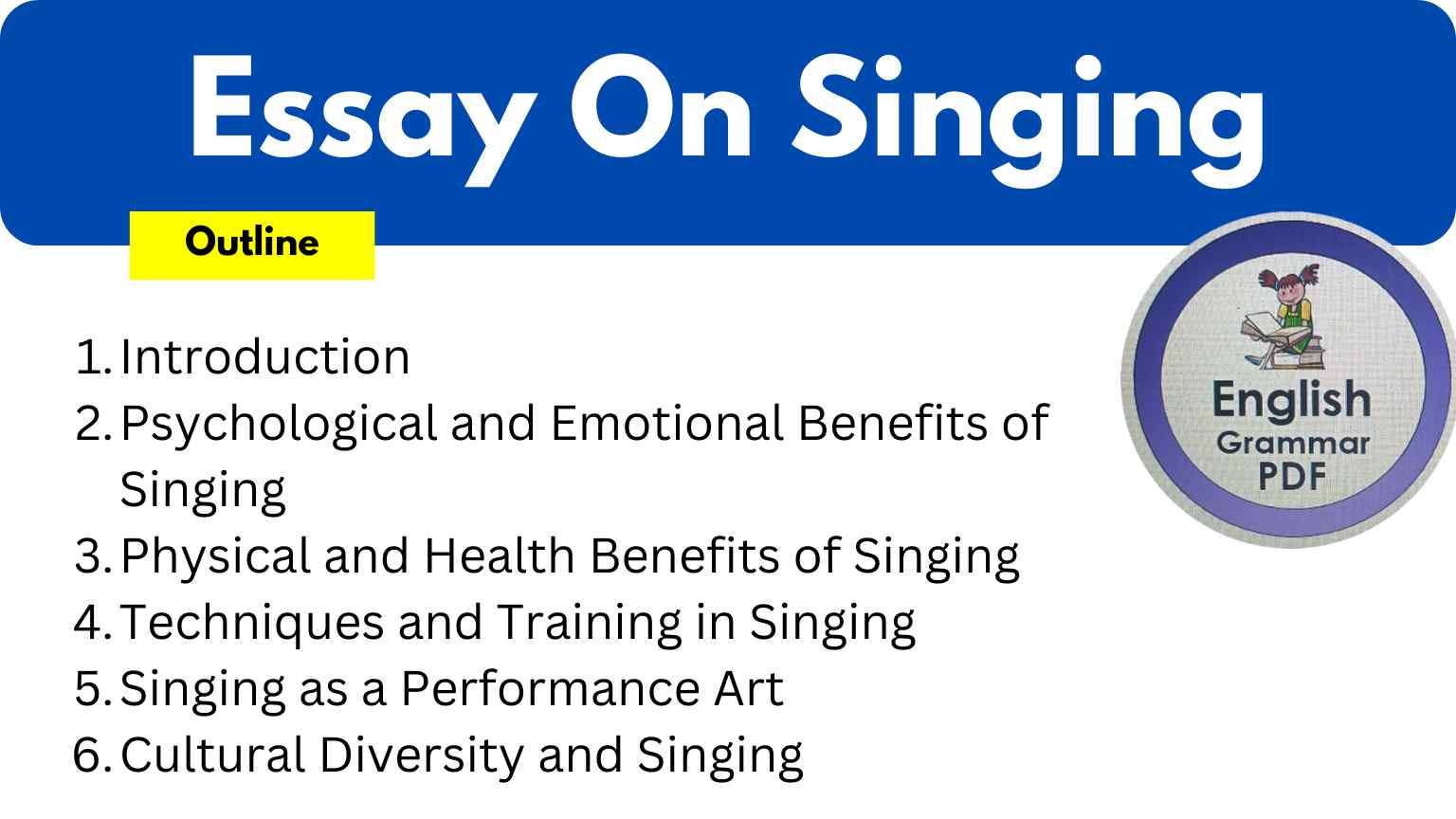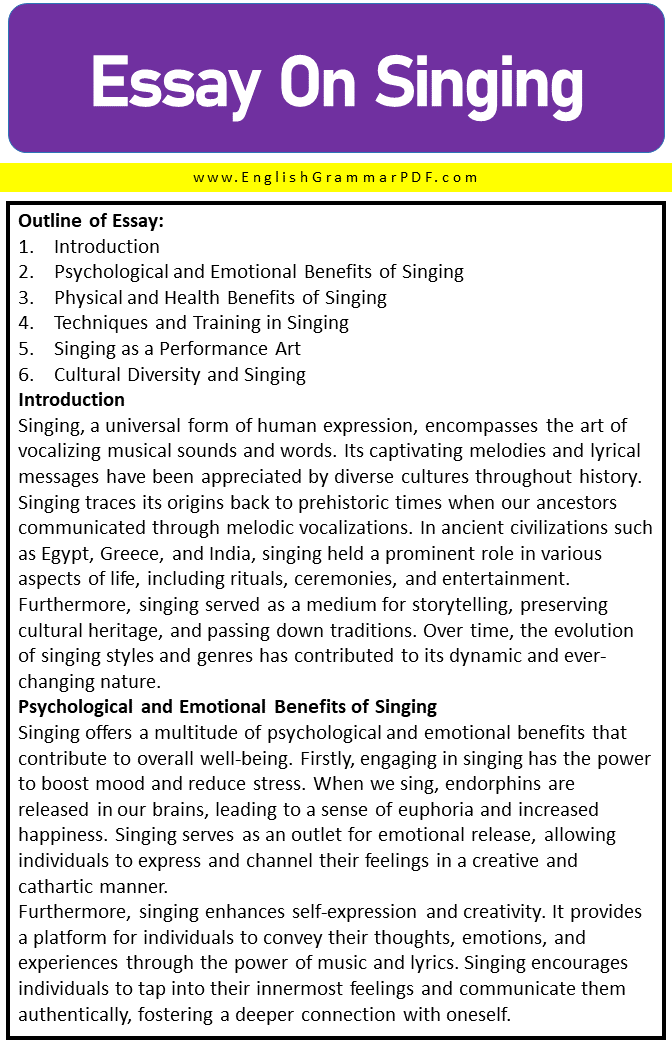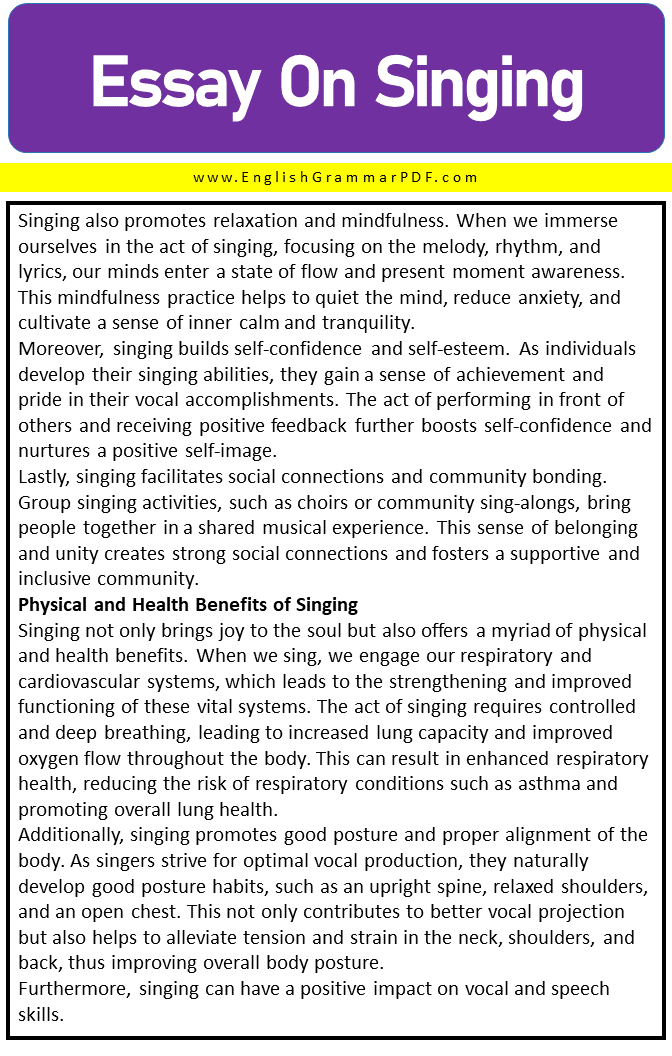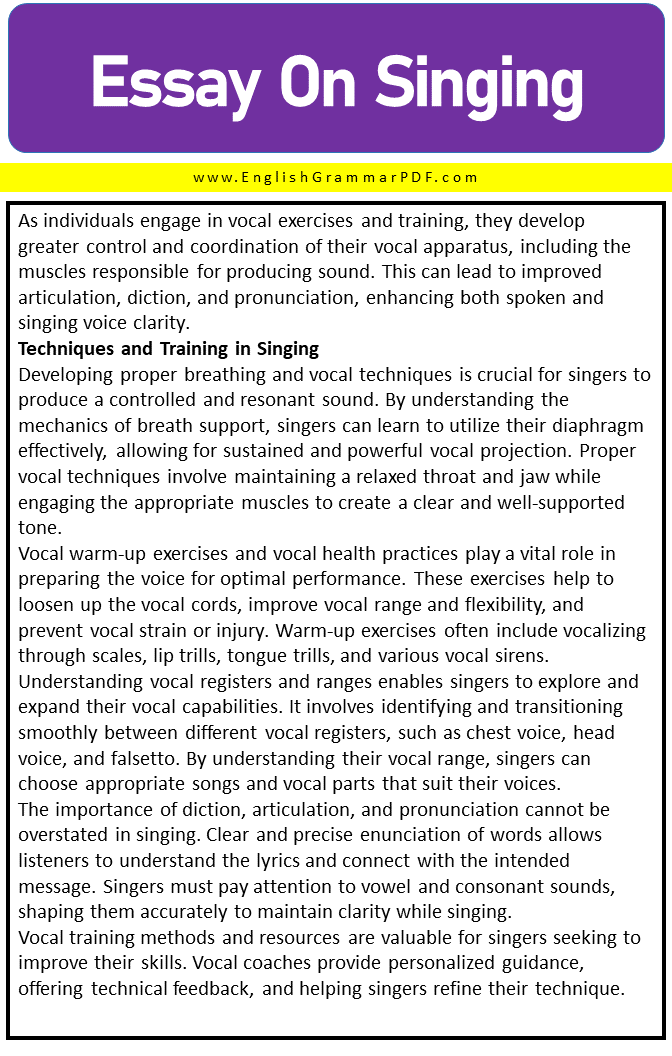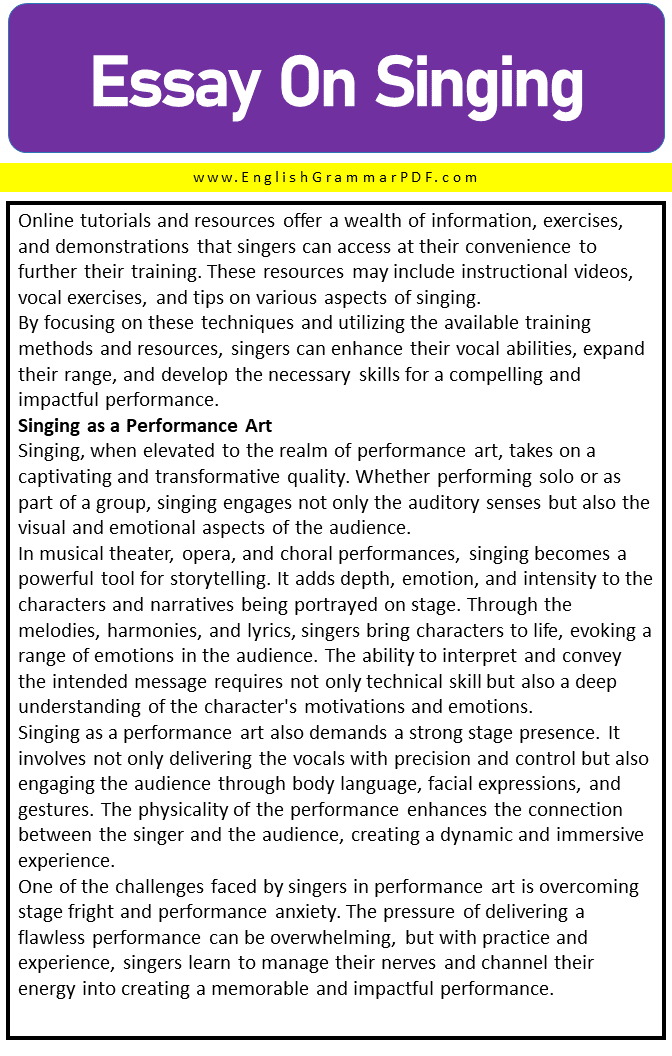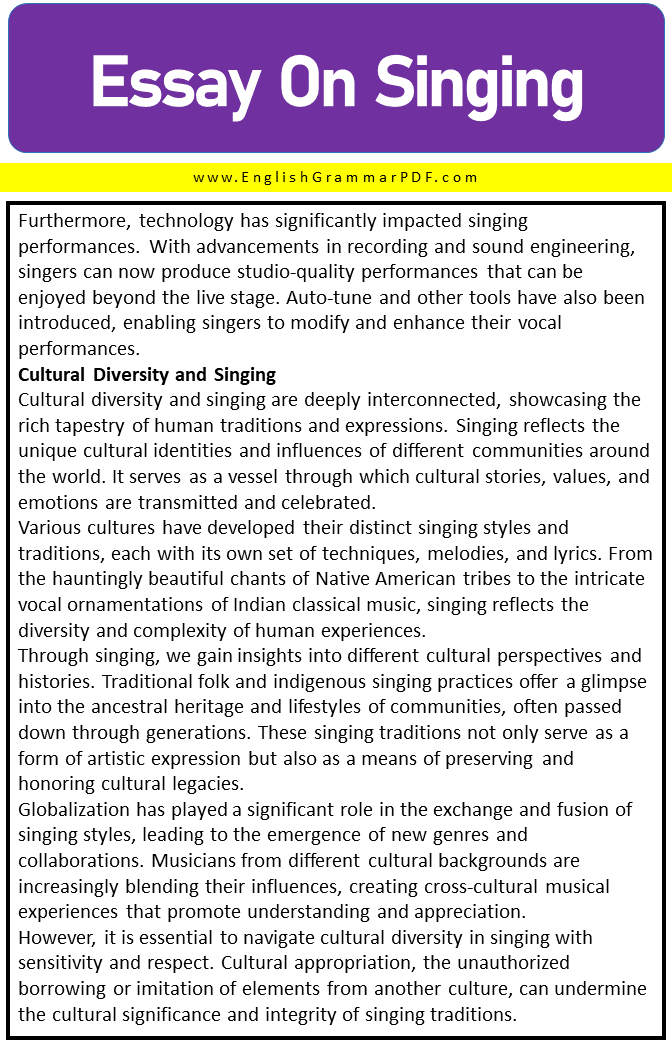Essay On Singing
Outline of Essay:
- Introduction
- Psychological and Emotional Benefits of Singing
- Physical and Health Benefits of Singing
- Techniques and Training in Singing
- Singing as a Performance Art
- Cultural Diversity and Singing
Introduction
Singing, a universal form of human expression, encompasses the art of vocalizing musical sounds and words. Its captivating melodies and lyrical messages have been appreciated by diverse cultures throughout history. Singing traces its origins back to prehistoric times when our ancestors communicated through melodic vocalizations. In ancient civilizations such as Egypt, Greece, and India, singing held a prominent role in various aspects of life, including rituals, ceremonies, and entertainment. Furthermore, singing served as a medium for storytelling, preserving cultural heritage, and passing down traditions. Over time, the evolution of singing styles and genres has contributed to its dynamic and ever-changing nature.
Psychological and Emotional Benefits of Singing
Singing offers a multitude of psychological and emotional benefits that contribute to overall well-being. Firstly, engaging in singing has the power to boost mood and reduce stress. When we sing, endorphins are released in our brains, leading to a sense of euphoria and increased happiness. Singing serves as an outlet for emotional release, allowing individuals to express and channel their feelings in a creative and cathartic manner.
Furthermore, singing enhances self-expression and creativity. It provides a platform for individuals to convey their thoughts, emotions, and experiences through the power of music and lyrics. Singing encourages individuals to tap into their innermost feelings and communicate them authentically, fostering a deeper connection with oneself.
Singing also promotes relaxation and mindfulness. When we immerse ourselves in the act of singing, focusing on the melody, rhythm, and lyrics, our minds enter a state of flow and present moment awareness. This mindfulness practice helps to quiet the mind, reduce anxiety, and cultivate a sense of inner calm and tranquility.
Moreover, singing builds self-confidence and self-esteem. As individuals develop their singing abilities, they gain a sense of achievement and pride in their vocal accomplishments. The act of performing in front of others and receiving positive feedback further boosts self-confidence and nurtures a positive self-image.
Lastly, singing facilitates social connections and community bonding. Group singing activities, such as choirs or community sing-alongs, bring people together in a shared musical experience. This sense of belonging and unity creates strong social connections and fosters a supportive and inclusive community.
Physical and Health Benefits of Singing
Singing not only brings joy to the soul but also offers a myriad of physical and health benefits. When we sing, we engage our respiratory and cardiovascular systems, which leads to the strengthening and improved functioning of these vital systems. The act of singing requires controlled and deep breathing, leading to increased lung capacity and improved oxygen flow throughout the body. This can result in enhanced respiratory health, reducing the risk of respiratory conditions such as asthma and promoting overall lung health.
Additionally, singing promotes good posture and proper alignment of the body. As singers strive for optimal vocal production, they naturally develop good posture habits, such as an upright spine, relaxed shoulders, and an open chest. This not only contributes to better vocal projection but also helps to alleviate tension and strain in the neck, shoulders, and back, thus improving overall body posture.
Furthermore, singing can have a positive impact on vocal and speech skills. As individuals engage in vocal exercises and training, they develop greater control and coordination of their vocal apparatus, including the muscles responsible for producing sound. This can lead to improved articulation, diction, and pronunciation, enhancing both spoken and singing voice clarity.
Techniques and Training in Singing
Developing proper breathing and vocal techniques is crucial for singers to produce a controlled and resonant sound. By understanding the mechanics of breath support, singers can learn to utilize their diaphragm effectively, allowing for sustained and powerful vocal projection. Proper vocal techniques involve maintaining a relaxed throat and jaw while engaging the appropriate muscles to create a clear and well-supported tone.
Vocal warm-up exercises and vocal health practices play a vital role in preparing the voice for optimal performance. These exercises help to loosen up the vocal cords, improve vocal range and flexibility, and prevent vocal strain or injury. Warm-up exercises often include vocalizing through scales, lip trills, tongue trills, and various vocal sirens.
Understanding vocal registers and ranges enables singers to explore and expand their vocal capabilities. It involves identifying and transitioning smoothly between different vocal registers, such as chest voice, head voice, and falsetto. By understanding their vocal range, singers can choose appropriate songs and vocal parts that suit their voices.
The importance of diction, articulation, and pronunciation cannot be overstated in singing. Clear and precise enunciation of words allows listeners to understand the lyrics and connect with the intended message. Singers must pay attention to vowel and consonant sounds, shaping them accurately to maintain clarity while singing.
Vocal training methods and resources are valuable for singers seeking to improve their skills. Vocal coaches provide personalized guidance, offering technical feedback, and helping singers refine their technique. Online tutorials and resources offer a wealth of information, exercises, and demonstrations that singers can access at their convenience to further their training. These resources may include instructional videos, vocal exercises, and tips on various aspects of singing.
By focusing on these techniques and utilizing the available training methods and resources, singers can enhance their vocal abilities, expand their range, and develop the necessary skills for a compelling and impactful performance.
Singing as a Performance Art
Singing, when elevated to the realm of performance art, takes on a captivating and transformative quality. Whether performing solo or as part of a group, singing engages not only the auditory senses but also the visual and emotional aspects of the audience.
In musical theater, opera, and choral performances, singing becomes a powerful tool for storytelling. It adds depth, emotion, and intensity to the characters and narratives being portrayed on stage. Through the melodies, harmonies, and lyrics, singers bring characters to life, evoking a range of emotions in the audience. The ability to interpret and convey the intended message requires not only technical skill but also a deep understanding of the character’s motivations and emotions.
Singing as a performance art also demands a strong stage presence. It involves not only delivering the vocals with precision and control but also engaging the audience through body language, facial expressions, and gestures. The physicality of the performance enhances the connection between the singer and the audience, creating a dynamic and immersive experience.
One of the challenges faced by singers in performance art is overcoming stage fright and performance anxiety. The pressure of delivering a flawless performance can be overwhelming, but with practice and experience, singers learn to manage their nerves and channel their energy into creating a memorable and impactful performance.
Furthermore, technology has significantly impacted singing performances. With advancements in recording and sound engineering, singers can now produce studio-quality performances that can be enjoyed beyond the live stage. Auto-tune and other tools have also been introduced, enabling singers to modify and enhance their vocal performances.
Cultural Diversity and Singing
Cultural diversity and singing are deeply interconnected, showcasing the rich tapestry of human traditions and expressions. Singing reflects the unique cultural identities and influences of different communities around the world. It serves as a vessel through which cultural stories, values, and emotions are transmitted and celebrated.
Various cultures have developed their distinct singing styles and traditions, each with its own set of techniques, melodies, and lyrics. From the hauntingly beautiful chants of Native American tribes to the intricate vocal ornamentations of Indian classical music, singing reflects the diversity and complexity of human experiences.
Through singing, we gain insights into different cultural perspectives and histories. Traditional folk and indigenous singing practices offer a glimpse into the ancestral heritage and lifestyles of communities, often passed down through generations. These singing traditions not only serve as a form of artistic expression but also as a means of preserving and honoring cultural legacies.
Globalization has played a significant role in the exchange and fusion of singing styles, leading to the emergence of new genres and collaborations. Musicians from different cultural backgrounds are increasingly blending their influences, creating cross-cultural musical experiences that promote understanding and appreciation.
However, it is essential to navigate cultural diversity in singing with sensitivity and respect. Cultural appropriation, the unauthorized borrowing or imitation of elements from another culture, can undermine the cultural significance and integrity of singing traditions. Instead, embracing cultural appreciation promotes dialogue, understanding, and unity, allowing for genuine collaborations and the celebration of diversity in singing.
FAQ’s
Is singing talent or skill?
Singing is both a talent and a skill. While some individuals possess a natural inclination or talent for singing, anyone can develop and improve their singing abilities through dedicated practice and training.
Why is singing creative?
Singing is creative because it involves the expression of oneself through the interpretation of lyrics, melody, and vocal techniques. Singers have the freedom to add their unique style, emotions, and interpretations, making each performance a creative and personal expression of their artistry.
Download the PDF of the Essay:
Explore More Essays:
